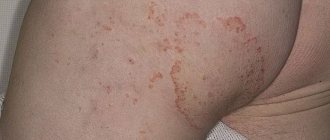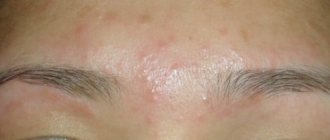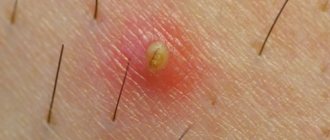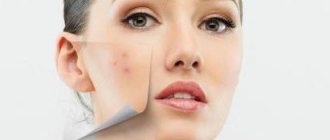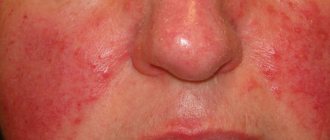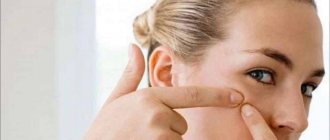A child has pimples on his butt - reasons
There are many factors that can lead to the appearance of rashes on children's skin. First of all, it is necessary to pay attention to the nature of the rash, the degree of damage and the age of the child.
In newborns
- One of the causes of pimples in newborns is diaper dermatitis. This disease is an inflammation of the skin in the buttock area. The cause of the development of dermatitis is considered to be poor hygiene and prolonged exposure to dirty diapers. Ammonia contained in mole and feces irritates the baby's delicate skin, which leads to rashes.
- A common cause of acne is an allergic reaction to care products (wipes, soap, diapers). In order to avoid allergies, it is advisable to choose products without fragrances and intended for children.
- Pimples around the anus may indicate a food allergy. Therefore, you should reconsider your diet.
- Staph infection is also a cause of the rash. It can appear not only on the child’s buttocks, but also on other mucous membranes.
- Another reason is climate. The rash often appears due to inappropriate temperature in the room where the child is. If your baby sweats, rashes can appear on any part of the body.
In children of the first years of life
The first place among the causes of rashes is allergies and poor hygiene. At this age, parents should actively monitor the baby’s health and instill in him knowledge about personal hygiene.
At the age of 1-2 years, the baby is taught to go to the potty, but it takes time until the child himself asks to go to the toilet. Parents need to change their children's underwear on time to prevent rashes.
The first years of life involve a transition to a normal diet. Because of this, problems often arise with the child’s digestive system. Rashes become a reaction to certain foods, so it is necessary to monitor the general condition of the baby and his stool.
Parents should be alerted to the presence in stool of:
- bleeding;
- mucus;
- white clots.
The presence of the above symptoms may indicate dysbacteriosis. If there is abdominal pain, loss of appetite and anxiety in the baby, then the development of gastrointestinal diseases or helminth infection is possible.
Another cause is considered to be infectious diseases: scabies, candidiasis, scarlet fever, measles, rubella. If an infection occurs in the baby’s body, the rash affects not only the butt, but also other parts of the body.
If redness appears after going outside, then a possible cause is hypothermia. To protect yourself from the cold, you should choose the right clothing.
From 2 to 6 years
From the age of 3, a child is enrolled in a kindergarten where there are other children, and the risk of contracting an infection increases accordingly. At this time, it is important to strengthen the baby's immunity.
To avoid hypothermia, walks in the fresh air should take place for a set period of time; you should not sit on cold benches or other surfaces. The anus area is sensitive to low temperatures, so it is important to keep your baby's body warm.
To prevent rashes, you need to choose clothes made from natural fabrics. You should avoid synthetic fabrics that do not conduct air and do not allow the skin to breathe.
At this age, the rash appears due to poor personal hygiene, eating unwashed fruits and vegetables, as well as large amounts of sweets.
After 7 years and older
At an older age, in some cases the child can explain and eliminate the cause of the rash on his own (for example, change underwear, take a shower).
Infectious diseases are less common, since children by school age have a number of vaccinations that protect them. The older the child becomes, the easier it is for him to explain the area of discomfort, make a diagnosis accordingly and eliminate the rash.
The cause of the rash may be puberty, during which hormonal levels become disrupted. The peak of change in a child’s body occurs individually, so it is impossible to determine the exact age of maturation. It should be remembered that in modern children growth begins much earlier.
The next reason for a rash on the butt is stress and overexertion. The first time at school can be a real test for a child due to adaptation to the environment and a new team. Completing homework, poor grades and separation from parents often upsets the child, which can lead to health problems.
Sudden changes in air temperature also cause rashes. The most dangerous period is autumn and spring, when the temperature outside changes throughout the day. Parents should monitor their child's clothing to prevent overheating and hypothermia.
Eating large amounts of sweets and fast food has an adverse effect on the condition of the child’s body, in particular the skin. As a result of metabolic disorders, a child may develop rashes on the buttocks.
The main types of rashes in infants
Clinical picture
For parents, their baby is the best. They try to do everything possible to protect it from the negative influences of the environment. However, this does not always work out.
Sometimes a baby will develop spots of unknown origin on his body. It could be a teething rash, an allergic reaction, or something else.
In any case, parents need to know what types of rashes exist in order to be able to diagnose their child’s condition if necessary.
What kind of rash happens?
There are many types of rashes that occur on the abdomen, neck, chest, back, butt, groin, arms and legs, chin and around the mouth.
To determine the reason for these pimples, you need to contact your pediatrician. Only he will be able to clearly determine what kind of rash the child has and how to deal with it.
Main types of rashes:
- Infectious rash.
- Miliaria (red rash).
- Allergic reaction.
- Dermatitis (contact, atopic, diaper).
- A rash that appears as a result of taking medications.
- Neonatal rash on legs.
All types of rashes can be divided into two main groups: hormonal and allergic. Let's look at the causes of the rash in each case.
Manifestation of allergies
Allergic rashes are most common among infants. There can be many reasons for its appearance.
- The mother wants to diversify her child’s diet and tries to constantly add something new to it. Of course, it’s worth doing this, but gradually. If you introduce a new product, wait for the baby’s body’s reaction to see whether redness appears in the mouth or not. Only after this can you try something else.
- Often, pimples on the back may appear after a massage using baby creams and oils. Carefully study their composition, they may contain allergens. Only when you are sure that the baby is not allergic to the components can you use the purchased massage products.
- If your child is breastfed and develops a small red rash around the mouth and neck, this is a reaction to the baby formula.
- Introducing complementary foods too early. An allergy around the mouth can be a signal to parents that the child’s body is not ready for new foods.
Acne is very common in young children, especially in the first few weeks after birth. Most often, a hormonal rash can be seen on the baby's neck, on the cheeks and under the hair. It is important to know that these spots on the skin are not dangerous and do not expose other people to the risk of infection.
The simplest hygiene rules will help you get rid of the problem. If after a few weeks of following them the spots do not go away, it is recommended to consult a dermatologist, he will prescribe special ointments. After them, everything can go away the very next day.
Types of rash
Skin rashes in a child can be of different types. After determining what is needed, the reasons for its occurrence are identified.
- Hyperhidrosis. A red rash in infants is not uncommon. It appears when the body is severely overheated. The vessels become clogged, preventing air from circulating. As a result, pimples and small rashes form on the neck and butt, on the legs, under the knees and in the armpits, on the chin and around the mouth, in the groin. Frequent showers and other hygiene methods will help get rid of the disease.
- Toxic erythema is also characterized by the formation of scarlet spots. They mainly appear in children in the first weeks of life on the face and neck. Usually such redness goes away on its own.
- Incorrect care. If parents rarely bathe the baby and do not pay proper attention to his hygiene, red pimples begin to form all over the body, including on the butt and groin.
The child suffers from severe itching and discomfort. You can get rid of diaper rash only by constant water procedures and the use of ointments with a drying effect.
Minor rash
Almost always, babies develop a small rash due to an allergic reaction of any origin. In this situation, it is important for parents to eliminate the root cause.
Often spots on the body and chest appear after a massage. Parents believe that it should be made with various store-bought oils, but do not look at the composition of the product. Try using natural ingredients for massage and the allergy will go away.
You can determine why a child has spots on his body by their location.
On the face
Causes:
- sudden change in temperature;
- genetic disorders;
- infectious diseases;
- allergy;
- disturbances in the functioning of the stomach and intestines.
Very often, a rash appears on the neck and around the mouth in infants due to diathesis. Moreover, both breastfed and bottle-fed children are susceptible to the disease. Having received a share of the allergen, the body reacts with red rashes around the mouth and neck. To get rid of them, the child must follow a diet for some time.
On the body
- If the spots on the stomach and back, on the chest are light in color and do not merge together, this means that they are caused by a contact allergy. Maybe it's washing powder or other detergents. Try to eliminate the cause and see if the spots on your stomach and back disappear.
- If the spots on the stomach and neck were initially white, then turned red and merged together, this is already a reason for panic. This sign is evidence of intoxication of the body. The baby must be urgently hospitalized to remove the allergen.
On the stomach
Minor rashes in the abdominal area sometimes indicate serious illnesses. Only a qualified doctor can determine the true cause of their occurrence.
Possible ailments:
- prickly heat;
- staphylococcus;
- blood diseases;
- rubella;
- lichen;
- dermatitis;
- scarlet fever.
If you notice symptoms in the form of a rash, you should consult a doctor to diagnose the disease in the infant.
On the butt
If small pimples begin to appear on the baby’s butt and groin, this indicates non-compliance with hygiene standards and rules. Children's intimate places require constant care, otherwise it is fraught with unpleasant consequences.
What can help if you notice a rash in the groin and butt? This:
- drying ointments;
- constant change of diapers, panties and bed linen;
- air baths;
- bathing with herbs (if there are no allergies).
If you follow these simple rules, the rash on your butt will go away very quickly. The most important thing is to never forget about them.
The best prevention for any rash is hygiene. If you do not want to further treat your child for allergies after a massage, for spots on the butt, on the chin and around the mouth, on the chest, just bathe your baby more often and always monitor the composition of the products and food products used.
Types of acne in children on the buttocks
Depending on the type and appearance of acne, you can determine the cause of its appearance.
Reds
If red pimples appear in a child, they are diagnosed with:
- diaper dermatitis;
- heat rash;
- allergies.
In order to distinguish the cause of the rash, you should remember the main differences between the diseases.
- Diaper dermatitis is characterized by a rash of small pimples on various parts of the body. The red spots may have a watery content that turns into a crust over time. Dermatitis occurs due to improper hygiene and greatly worries the child. Because of the burning sensation, the baby becomes restless and often cries;
- with prickly heat, pimples are located on different parts of the body, without touching each other and without inflaming the skin;
- the allergy manifests itself immediately throughout the entire buttock area. After a few days, the pimples dry out and the skin begins to peel. If rashes are not treated promptly, wounds and cracks may form, which cause the development of bacteria.
Red pimples appear as a result of the development of infectious diseases:
- measles;
- rubella;
- chickenpox.
Types of pimples
A pimple is a local rash caused by disruption of the sebaceous glands at the site of its appearance. Almost every person has encountered this phenomenon in adolescence, when hormonal changes in the body lead to the face becoming covered with a scattering of pimples and blackheads. For many, this goes away with age, and some suffer from periodic rashes throughout their lives.
In addition to the face, the shoulders, back and chest are prone to frequent acne. Less commonly - arms, legs and buttocks.
Types of rashes:
- A closed comedon is an ordinary small pimple with a white head. They are harmless and appear due to blockage of the pore or hair opening with dirt particles. Comedones do not hurt, do not itch, and go away on their own quite quickly. The open types of these rashes - blackheads - do not appear on the butt, since the pores in this place are too small for their formation.
- A cyst is a reddish swelling filled inside with serous fluid.
- Papule - externally resembles a cystic pimple, but without substance inside, being just a skin nodule.
- Pustule. A deeper formation, painful and filled with pus.
- The node is a large, red, painful rash. It can be connected to neighboring ones, forming a group of pimples.
- Furuncle. A pimple filled with pus, the appearance of which is caused by exposure to bacteria (usually staphylococcus). It is characterized by very severe pain, up to the inability to sit if it occurs on the butt.
- Inflammation of several hair follicles located nearby can lead to the formation of a carbuncle. It occurs as a result of a bacterial attack, like a boil, but is a much more serious formation. If the immune system is weakened, it can lead to sepsis.
In addition to the types of acne described, allergic rashes, various types of rashes, or mild pimples that appear after any illness may occur on the fifth point. They are a way to remove decay products of a previous infection and do not cause any inconvenience.
What diseases cause acne on a child's bottom?
The appearance of a rash on a child’s buttocks may indicate the presence of infectious diseases:
- Rubella is characterized by the appearance of small pink rashes.
- Measles. Small bright red dots appear all over the body, first on the face and arms, then down to the butt.
- Scarlet fever. The symptoms are similar to measles. Red pimples, high fever and sore throat appear.
- Roseola. Characterized by the presence of high fever and pink pimples.
- Chickenpox. During illness, small blisters appear throughout the body, which eventually turn into crusts.
Infectious diseases very quickly affect a child’s body, so it is important to diagnose and begin treatment in a timely manner.
Danger
The most dangerous are boils that appear on the face - on the cheek, on the nose, on the eyelid, in the ear, on the scalp, on the neck, since this location creates additional risks of infection of the brain and the development of sepsis.
Many do not understand how pus can penetrate there, but this gap in knowledge is restored simply - it breaks through where it is thin. If the boil is superficial, the pus will come up and out. If the boil is deep, then the breakthrough may be internal, and this will be the main prerequisite for systemic infection.
We suggest that you familiarize yourself with the Causes and treatment of atheroma cysts on the back under the skin
A boil in an infant and a newborn is a double danger, and therefore it is customary to treat such children in a hospital. Older children may be left to treat themselves at home.
Many do not understand how pus can penetrate there, but this gap in knowledge is restored simply - it breaks through where it is thin. If the boil is superficial, the pus will come up and out. If the boil is deep, then the breakthrough may be internal, and this will be the main prerequisite for systemic infection.
A boil in an infant and a newborn is a double danger, and therefore it is customary to treat such children in a hospital. Older children may be left to treat themselves at home.
How to treat acne on the buttocks in children?
It should be remembered that the treatment of acne on the butt depends on the diagnosis and the age of the child. In any case, you should not self-medicate and squeeze out pimples. Complex therapy is often required, which includes the use of medications and personal hygiene.
Drug treatment
Medicines must be prescribed by a doctor. Vitamin complexes, as well as products high in calcium and magnesium, are often used.
To treat purulent pimples, zinc ointment or salicylic alcohol is prescribed. Children after one year of age are allowed to use medications.
“Zinerit” is used to treat acne on the butt. It is applied to clean skin 2 times a day. An analogue of “Zinerit” is “Skinoren”; it also fights purulent pimples well.
The drugs should not be used to treat children under 3 years of age.
Traditional methods
Traditional medicine for the treatment of acne on the butt allows the use of:
- chamomile;
- soda;
- oak bark;
- bay leaf;
- calendula;
- potassium permanganate.
Chamomile, calendula or oak bark should be mixed with boiling water. This decoction has anti-inflammatory and antiseptic effects. Use baking soda to treat babies with caution, as a large dose can dry out the skin.
Hygiene rules
To prevent acne from appearing on your baby’s bottom, you should follow these rules:
- change underwear and diapers in a timely manner;
- use natural products to wash your baby;
- infants are washed after each trip to the toilet;
- To wash children, use soft sponges and napkins so as not to irritate delicate skin;
- regularly moisturize your baby’s skin with creams;
- monitor the child's nutrition.
What to do if pimples itch?
Itching can be caused by:
- skin irritation;
- allergies;
- scabies.
The first thing to do is to prevent scratching your pimples. Your child's nails should be trimmed short to reduce the risk of skin damage.
The affected areas are covered with thick clothing. Before the doctor arrives, lotions made from green tea, mint or lemon balm will help reduce itching. Such tinctures should be used if the child does not have allergies.
With proper treatment, a rash on children's skin does not cause serious consequences. The main thing is to follow all the doctor’s recommendations and take preventive measures to prevent repeated reactions. It should be remembered that formations on the skin do not appear out of nowhere, so it is important to establish the cause of their appearance.
Important to remember
- A rash on the butt in children is quite common, especially in infants.
- The reasons for the appearance of rashes are very different. Different types of rashes are treated differently.
- An allergic rash has characteristic manifestations.
- If you have any type of rash on your child’s bottom, you should immediately contact a specialist to make the correct diagnosis and prescribe treatment.
See you in the next article!
Watch the video where Dr. Komarovsky talks about the rash.
